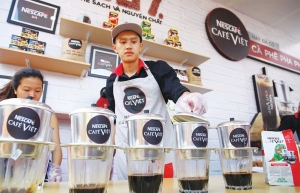Vietnam’s F&B market exciting for expanding Chinese chains
Having only entered the Vietnamese market late last year, Chinese coffee chain Cotti Coffee plans an aggressive expansion in Vietnam into next year as part of its strategy to reach 20,000 stores globally in 2025, according to Jen Yang, the company’s representative.
 |
| Vietnam’s F&B market exciting for expanding Chinese chains, photo: Cotti Coffee |
“We have already opened nearly 10 branches in Hanoi and Ho Chi Minh City,” Yang told VIR last week. “To build brand recognition and support our market expansion, our branches in Vietnam will use award-winning arabica beans recognised by the International Institute of Coffee Taster, consistent with our offerings in other markets. Additionally, we aim to maintain competitive pricing, positioning ourselves below Starbucks and several Vietnamese coffee chains.”
Cotti, which boasts over 6,000 outlets in China, also has a presence in challenging markets like Canada, Australia, and the UAE.
According to economic expert Le Xuan Nghia, many Chinese food and beverage (F&B) businesses like Cotti Coffee have a tremendous competitive edge over Vietnamese enterprises, fuelled by robust domestic market strength and strong government support.
“With a vast domestic market and international expansion capabilities, along with government-backed policies, Chinese companies benefit from large-scale production, low costs, and the ability to maintain competitive pricing. These factors not only allow them to easily penetrate the Vietnamese market but also overshadow local businesses on many fronts,” Nghia said.
“Without timely measures, Vietnamese F&B companies may find themselves at a disadvantage, gradually losing market share to their Chinese counterparts,” he warned.
Nguyen Tan Viet, chairman of the Food and Beverage Vietnam Association (FBA), highlighted the efficient supply chain and strong research and development (R&D) capabilities of Chinese groups.
“China boasts a comprehensive and efficient supply chain, from raw materials to transportation and distribution. This not only helps to cut costs but also enables Chinese companies to respond more swiftly to market fluctuations,” Viet said. “In contrast, Vietnamese companies may struggle to maintain a stable and efficient supply chain, particularly when relying on imported materials or technology.”
Chinese companies also often invest heavily in R&D, allowing them to quickly launch new products aligned with market trends. Meanwhile, Vietnamese businesses may find it difficult to keep up with this innovation due to limited resources and investment in R&D, Viet added.
Despite a recent decline in the number of existing stores, Mixue, a company offering products such as tea, milk tea, and ice cream is a familiar example of how a Chinese company can expand and dominate a market, having opened 1,000 stores across Vietnam in a variety of provinces in 2023. With a franchise strategy, the brand maintains a strong presence on most central streets in Hanoi.
According to Nguyen Dinh Cung, former director of the Central Institute for Economic Management, Chinese F&B companies have established highly successful business models, and for Vietnamese companies to catch up, they must precisely understand what their competitors are doing to build a solid foundation before innovating and developing further.
“Vietnamese companies should emulate the Chinese by focusing on R&D investment, which leads to market understanding and, as a result, makes it easier to achieve a strong market presence through large-scale and effective marketing strategies,” Cung said. “Moreover, with a deep understanding of the market, companies can create and spread new consumer trends, the most effective method to dominate the market before competitors can adapt.”
Additionally, he believes that one of the keys to the success of Chinese companies lies in their efficient supply chain. China has heavily invested in advanced technology and management processes, optimising the entire supply chain from production to distribution, reducing costs, and increasing the speed and accuracy of bringing products to market. He suggested that Vietnamese companies should pursue technological innovation to remain competitive.
“Vietnamese companies need to innovate more vigorously. Investing in modern technology, improving supply chain management, and fostering creativity are crucial factors to maintain a strong position in the industry and not fall behind,” Cung added.
However, even if Vietnamese firms wish to emulate these practices, they must have the necessary conditions to do so. Therefore, Viet from the FBA hopes that the government will play a larger role in the sector’s development through more active support policies for businesses.
“Currently, the Vietnamese government has financial support programmes for F&B companies with R&D projects, as well as technology innovation, such as the National Technology and Science Development Fund. Businesses are also supported when they obtain certifications for food safety, which help enhance product value. However, I still hope for additional policies to improve logistics infrastructure, aimed at reducing costs and increasing efficiency in F&B product distribution,” Viet said.
 | F&B titans injecting new cash for facilities The domestic food and beverage industry remains one of the most attractive segments in Vietnam, with local and foreign companies beefing up investment. |
 | F&B still attractive for players old and new The food and beverages market in 2024 is expected to become more competitive, with the appearance of a number of foreign brands and the rankings of domestic brands ever-changing. |
 | F&B is still a game for TOP brands With a growth rate of more than 10 per cent per year, the food and beverage market is still a vibrant playground led by big brands. |
 | Gen Z shaping the future of F&B industry Younger Vietnamese people are shaping the food and beverage industry with their preference for local items. |
 | F&B market taking on fresh appeal Vietnam’s food and beverage market is emerging as a hotbed of opportunity, with several companies from neighbouring nations as well as those further afield ramping up activity. |
 | Seizing opportunities in F&B With an average annual growth rate of over 10 per cent, the food and beverages (F&B) market in Vietnam is a dynamic sector. Director of Consumer and Marketing Insights at NielsenIQ Dang Thuy Ha discussed with VIR’s Oanh Do the latest consumer trends helping businesses achieve success in the market. |
What the stars mean:
★ Poor ★ ★ Promising ★★★ Good ★★★★ Very good ★★★★★ Exceptional
Related Contents
Latest News
More News
- Businesses ramp up production as year-end orders surge (December 30, 2025 | 10:05)
- Vietjet chairwoman awarded Labour Hero title (December 29, 2025 | 13:06)
- How to unlock ESG value through green innovation (December 29, 2025 | 10:03)
- AI reshapes media and advertising industry (December 29, 2025 | 08:33)
- FPT and GELEX sign deal to develop blockchain tech for global markets (December 29, 2025 | 08:29)
- Vietnam’s GDP forecast to grow by 9 per cent in 2026 (December 29, 2025 | 08:29)
- Women entrepreneurs are key to Vietnam’s economic growth (December 29, 2025 | 08:00)
- Vietnam's top 500 value-creating enterprises announced (December 27, 2025 | 08:00)
- The PAN Group shaping a better future with ESG strategy (December 26, 2025 | 09:00)
- Masan Consumer officially lists on HSX, marking the next phase of value creation (December 25, 2025 | 13:20)

 Tag:
Tag:




















 Mobile Version
Mobile Version